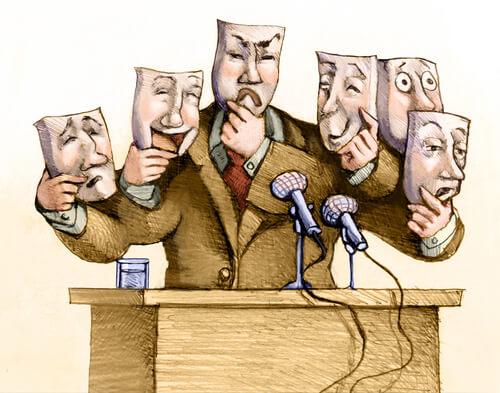Three Political Propaganda Tactics

Although political propaganda fell into disuse in the last decades of the 20th century, its effects are still noticeable today. Nowadays, due to social media and other platforms, this concept is camouflaged as persuasion or advertisement.
What is political propaganda?
Political propaganda is a type of communication that makes up part of social and political systems. This concept has been studied a lot throughout history. In order to be able to understand the concept of political propaganda, we must explain three fundamental criteria:
- Content: The propaganda content must be political. The message could look non-political at first but, after examining it a little more, we’ll find its political association.
- Control over the message: An important factor here is that the issuer has 100% of the control over the message. This is true in the production stages and in the broadcasting.
- Objective: The objective of the message is to promote the interests and ideas of the issuer. Meanwhile, the message also intends to spark a certain response from the audience with a predetermined objective.
In this article, we’ll discuss some of the techniques used in political propaganda.

Labeling techniques
These techniques use some sort of labeling as a main resource. The idea is to use certain terms that have an emotional or conceptual resonance in order to associate the message with positive or negative aspects. There are many ways to apply this technique in political propaganda:
- Use of negative labels: When something is negatively labeled, despite the fact that there isn’t enough information to back this negative label. One clear example is calling a group of people “evil” just because they represent different ideas.
- Asymmetric definition: Taking advantage of the ambiguities of some words to make sure the audience receives a message that strays from reality. An example of this is when politicians say that the objective of war is to achieve peace. An ordinary citizen and a governing body don’t define peace the same way.
- Echoing generalization: The use of vague phrases with a huge emotional load. For example, when a candidate promises to bring “great change” to a country.
Association techniques
These strategies are used to make sure that the receptors associate the characteristics of a specific concept (positive or negative) with another that’s initially neutral for the audience.
- Juxtaposition: Associating independent ideas by putting them together. This works even without even implicitly relating the two ideas. For example, “person X is authoritative and person Y plays golf with person X every Thursday”. Here, the idea is to make person X look as authoritative as person Y.
- Virtuous words: Using certain words that generate positive emotions in the audience. An example of this is using words like “liberty”, “safety”, and “truth” in speeches.
- Ordinary people: Using images that identify with people’s everyday lives, their customs, and language to make them feel a sense of belonging. For example, using pictures of young, medium class couples in political advertisements.

Techniques based on source reliability
The main goal of these techniques is to resort to a reliable source to validate an idea or message. Some examples of this include:
- Making up a meaning through secret sources: Using sources whose identity is never revealed and is always spoken about in general terms by citing that experts back up a message without calling out specific people. This uses anonymity to avoid backing up a message. An example of this is a message along the lines of “Sources confirm that party X is being financed illegally”.
- Wise men can’t be wrong: Citing prestigious people that validate an idea or message. For example, “X person said this… and if this person said it, nobody can disregard it”.
- Condemn the source: Discrediting an idea by only attacking its source. A clear example of this is to call someone a liar in order to break their message apart. In philosophical circles, this is known as an ad hominem attack.
In conclusion
This article has touched on a few political propaganda tactics. However, there are many more in existence. It would be naive to think that we aren’t influenced by this political propaganda. This is why it’s important to know its techniques so we can avoid being persuaded by political powers.
This text is provided for informational purposes only and does not replace consultation with a professional. If in doubt, consult your specialist.








